Multifractal Characteristics and Displacement Prediction of Deformation on Tunnel Portal Slope of Shallow Buried Tunnel Adjacent to Important Structures
Abstract
1. Introduction
2. Materials and Methods
2.1. Overview of the Tunnel Project
2.2. Deformation Monitoring Program for Tunnel Portal Slope
2.3. Multifractal Detrended Fluctuation Analysis Method
2.4. PSO-LSTM Algorithm
2.4.1. Principles of the LSTM Algorithm
2.4.2. Principles of the PSO Algorithm
2.4.3. PSO Optimized LSTM Model
3. Results
3.1. Deformation Monitoring Results of Tunnel Portal Slope
3.2. MultiFractal Characteristics of Deformation of Elevation Slope at Tunnel Portals
3.2.1. Horizontal Displacement Multifractal Characterization
3.2.2. Vertical Displacement Multifractal Characterization
3.3. PSO-LSTM Prediction of Slope Deformation at Tunnel Portal Sides
3.3.1. Horizontal Displacement Prediction Results
3.3.2. Vertical Displacement Prediction Results
4. Discussion
5. Conclusions
- Combined with the deformation characteristics of the tunnel portal slope, design a suitable monitoring and measuring program to analyze the deformation pattern of the tunnel portal slope. After the deformation of the tunnel portal slope is stabilized, the horizontal displacement is about 6–8 mm, the vertical settlement value is not more than 2 mm, and the stability of the tunnel portal slope is high.
- Based on the MF-DFA method, analyze the multifractal characteristics of the deformation monitoring sequences at each monitoring point of the tunnel portal slope. The MF eigenvalues of the displacement sequences at different monitoring sections of the tunnel portal slope are more in line with the actual monitoring results. For the horizontal displacement sequences, the multifractal strengths of monitoring points N3, N5, and N7 are larger. For the vertical displacement sequence, the multifractal intensities of monitoring points N3, N4, and N6 are larger.
- The PSO-LSTM prediction model was utilized to predict the deformation development of the side slope of the tunnel portal. The maximum MSE value of the horizontal displacement test set prediction result is 0.142, and R2 is higher than 91%. The maximum MSE value of the vertical displacement test set prediction result is 0.069, and R2 is higher than 91%. The PSO-LSTM model has a small error in predicting the displacement sequence of each monitoring point, and the performance of the prediction model can meet the requirements for predicting the displacement of the portal slope of the tunnel portal.
Author Contributions
Funding
Data Availability Statement
Acknowledgments
Conflicts of Interest
References
- Gong, C.; Ding, W.; Mosalam, K.M.; Gunay, S.; Soga, K. Comparison of the structural behavior of reinforced concrete and steel fiber reinforced concrete tunnel segmental joints. Tunn. Undergr. Space Technol. 2017, 68, 38–57. [Google Scholar] [CrossRef]
- Lei, M.; Liu, L.; Shi, C.; Tan, Y.; Lin, Y.; Wang, W. A novel tunnel-lining crack recognition system based on digital image technology. Tunn. Undergr. Space Technol. 2021, 108, 103724. [Google Scholar] [CrossRef]
- Zhou, Z.; Zhang, J.; Gong, C. Automatic detection method of tunnel lining multi-defects via an enhanced You Only Look Once network. Comput.-Aided Civ. Infrastruct. Eng. 2022, 37, 762–780. [Google Scholar] [CrossRef]
- Bandini, A.; Berry, P.; Boldini, D. Tunnelling-induced landslides: The Val di Sambro tunnel case study. Eng. Geol. 2015, 196, 71–87. [Google Scholar] [CrossRef]
- Zhao, C.; Lei, M.; Shi, C.; Cao, H.; Yang, W.; Deng, E. Function mechanism and analytical method of a double layer pre-support system for tunnel underneath passing a large-scale underground pipe gallery in water-rich sandy strata: A case study. Tunn. Undergr. Space Technol. 2021, 115, 104041. [Google Scholar] [CrossRef]
- Jia, C.; Zhang, Q.; Lei, M.; Zheng, Y.; Huang, J.; Wang, L. Anisotropic properties of shale and its impact on underground structures: An experimental and numerical simulation. Bull. Eng. Geol. Environ. 2021, 80, 7731–7745. [Google Scholar] [CrossRef]
- Huang, L.; Ma, J.; Lei, M.; Liu, L.; Lin, Y.; Zhang, Z. Soil-water inrush induced shield tunnel lining damage and its stabilization: A case study. Tunn. Undergr. Space Technol. 2020, 97, 103290. [Google Scholar] [CrossRef]
- Lei, M.; Lin, D.; Huang, Q.; Shi, C.; Huang, L. Research on the construction risk control technology of shield tunnel underneath an operational railway in sand pebble formation: A case study. Eur. J. Environ. Civ. Eng. 2020, 24, 1558–1572. [Google Scholar] [CrossRef]
- Zhang, Y.; Yang, J.; Yang, F. Field investigation and numerical analysis of landslide induced by tunneling. Eng. Fail. Anal. 2015, 47, 25–33. [Google Scholar] [CrossRef]
- Zhou, Z.; Ding, H.; Miao, L.; Gong, C. Predictive model for the surface settlement caused by the excavation of twin tunnels. Tunn. Undergr. Space Technol. 2021, 114, 104014. [Google Scholar] [CrossRef]
- Aygar, E.B.; Gokceoglu, C. Effects of Portal Failure on Tunnel Support Systems in a Highway Tunnel. Geotech. Geol. Eng. 2021, 39, 5707–5726. [Google Scholar] [CrossRef]
- Ayoublou, F.F.; Taromi, M.; Eftekhari, A. Tunnel portal instability in landslide area and remedial solution: A case study. Acta Polytech. 2019, 59, 435–447. [Google Scholar] [CrossRef]
- Kaya, A.; Karaman, K.; Bulut, F. Geotechnical investigations and remediation design for failure of tunnel portal section: A case study in northern Turkey. J. Mt. Sci. 2017, 14, 1140–1160. [Google Scholar] [CrossRef]
- Lei, M.; Li, J.; Zhao, C.; Shi, C.; Yang, W.; Deng, E. Pseudo-dynamic analysis of three-dimensional active earth pressures in cohesive backfills with cracks. Soil Dyn. Earthq. Eng. 2021, 150, 106917. [Google Scholar] [CrossRef]
- Wang, Q.; Geng, P.; Li, P.; Chen, J.; He, C. Dynamic damage identification of tunnel portal and verification via shaking table test. Tunn. Undergr. Space Technol. 2023, 132, 104923. [Google Scholar] [CrossRef]
- Wang, Q.; Geng, P.; Chen, J.; He, C. Dynamic discrimination method of seismic damage in tunnel portal based on improved wavelet packet transform coupled with Hilbert-Huang transform. Mech. Syst. Signal Process. 2023, 188, 110023. [Google Scholar] [CrossRef]
- Genis, M. Assessment of the dynamic stability of the portals of the Dorukhan tunnel using numerical analysis. Int. J. Rock Mech. Min. Sci. 2010, 47, 1231–1241. [Google Scholar] [CrossRef]
- Tuncay, E. Assessments on slope instabilities triggered by engineering excavations near a small settlement (Turkey). J. Mt. Sci. 2018, 15, 114–129. [Google Scholar] [CrossRef]
- Wang, X.; Chen, J.; Zhang, Y.; Xiao, M. Seismic responses and damage mechanisms of the structure in the portal section of a hydraulic tunnel in rock. Soil Dyn. Earthq. Eng. 2019, 123, 205–216. [Google Scholar] [CrossRef]
- Jia, J. Application of PS-INSAR Technique on Health Diagnosis of the Deformable Body on Front Slope beside Mountain Tunnel Portal. Math. Probl. Eng. 2020, 2020, 8823382. [Google Scholar] [CrossRef]
- Feng, H.; Jiang, G.; He, Z.; Guo, Y.; Hu, J.; Li, J.; Yuan, S. Dynamic response characteristics of tunnel portal slope reinforced by prestressed anchor sheet-pile wall. Rock Soil Mech. 2023, 44S, 50–62. [Google Scholar]
- Zhang, Q.; Wang, J.; Zhang, H. Attribute recognition model and its application of risk assessment for slope stability at tunnel portal. J. Vibroeng. 2017, 19, 2726–2738. [Google Scholar] [CrossRef]
- Li, X.; Li, X.; Yang, C. A comparison study of face stability between the entering and exiting a shallow-buried tunnel with a front slope. Front. Earth Sci. 2022, 10, 987294. [Google Scholar] [CrossRef]
- Li, C.; Zheng, H.; Hu, Z.; Liu, X.; Huang, Z. Analysis of Loose Surrounding Rock Deformation and Slope Stability at Shallow Double-Track Tunnel Portal: A Case Study. Appl. Sci. 2023, 13, 50248. [Google Scholar] [CrossRef]
- Aygar, E.B.; Gokceoglu, C. Problems Encountered during a Railway Tunnel Excavation in Squeezing and Swelling Materials and Possible Engineering Measures: A Case Study from Turkey. Sustainability 2020, 12, 11663. [Google Scholar] [CrossRef]
- Taromi, M.; Eftekhari, A.; Hamidi, J.K.; Aalianvari, A. A discrepancy between observed and predicted NATM tunnel behaviors and updating: A case study of the Sabzkuh tunnel. Bull. Eng. Geol. Environ. 2017, 76, 713–729. [Google Scholar] [CrossRef]
- Zhu, B.; Lei, M.; Gong, C.; Zhao, C.; Zhang, Y.; Huang, J.; Jia, C.; Shi, C. Tunnelling-induced landslides: Trigging mechanism, field observations and mitigation measures. Eng. Fail. Anal. 2022, 138, 106387. [Google Scholar] [CrossRef]
- Xi, N.; Yang, Q.; Sun, Y.; Mei, G. Machine Learning Approaches for Slope Deformation Prediction Based on Monitored Time-Series Displacement Data: A Comparative Investigation. Appl. Sci. 2023, 13, 46778. [Google Scholar] [CrossRef]
- Intrieri, E.; Gigli, G.; Mugnai, F.; Fanti, R.; Casagli, N. Design and implementation of a landslide early warning system. Eng. Geol. 2012, 147, 124–136. [Google Scholar] [CrossRef]
- Dai, F.C.; Lee, C.F.; Ngai, Y.Y. Landslide risk assessment and management: An overview. Eng. Geol. 2002, 64, 65–87. [Google Scholar] [CrossRef]
- Lopes, R.; Betrouni, N. Fractal and multifractal analysis: A review. Med. Image Anal. 2009, 13, 634–649. [Google Scholar] [CrossRef]
- Liu, J.; Li, Q.; Wang, X.; Wang, Z.; Lu, S.; Sa, Z.; Wang, H. Dynamic multifractal characteristics of acoustic emission about composite coal-rock samples with different strength rock. Chaos Soliton Fract. 2022, 164, 112725. [Google Scholar] [CrossRef]
- Ehlen, J. Fractal analysis of joint patterns in granite. Int. J. Rock Mech. Min. Sci. 2000, 37, 909–922. [Google Scholar] [CrossRef]
- Li, W.; Zhao, H.; Wu, H.; Wang, L.; Sun, W.; Ling, X. A novel approach of two-dimensional representation of rock fracture network characterization and connectivity analysis. J. Petrol. Sci. Eng. 2020, 184, 106507. [Google Scholar] [CrossRef]
- Zhang, W.; Liu, D.; Tang, Y.; Qiu, W.; Zhang, R. Multifractal Characteristics of Smooth Blasting Overbreak in Extra-Long Hard Rock Tunnel. Fractal Fract. 2023, 7, 84212. [Google Scholar] [CrossRef]
- Liu, D.; Zhang, W.; Jian, Y.; Tang, Y.; Cao, K. Damage precursors of sulfate erosion concrete based on acoustic emission multifractal characteristics and b-value. Constr. Build. Mater. 2024, 419, 135380. [Google Scholar] [CrossRef]
- Wasowski, J.; Bovenga, F. Investigating landslides and unstable slopes with satellite Multi Temporal Interferometry: Current issues and future perspectives. Eng. Geol. 2014, 174, 103–138. [Google Scholar] [CrossRef]
- Gariano, S.L.; Guzzetti, F. Landslides in a changing climate. Earth-Sci. Rev. 2016, 162, 227–252. [Google Scholar] [CrossRef]
- Li, Z.; Cheng, P.; Zheng, J. Prediction of time to slope failure based on a new model. Bull. Eng. Geol. Environ. 2021, 80, 5279–5291. [Google Scholar] [CrossRef]
- Feng, X.T.; Zhao, H.B.; Li, S.J. Modeling non-linear displacement time series of geo-materials using evolutionary support vector machines. Int. J. Rock Mech. Min. Sci. 2004, 41, 1087–1107. [Google Scholar] [CrossRef]
- Huang, Y.; Zhao, L. Review on landslide susceptibility mapping using support vector machines. Catena 2018, 165, 520–529. [Google Scholar] [CrossRef]
- Ma, Z.; Mei, G.; Prezioso, E.; Zhang, Z.; Xu, N. A deep learning approach using graph convolutional networks for slope deformation prediction based on time-series displacement data. Neural Comput. Appl. 2021, 33, 14441–14457. [Google Scholar] [CrossRef]
- Ma, Z.; Mei, G.; Piccialli, F. Machine learning for landslides prevention: A survey. Neural Comput. Appl. 2021, 33, 10881–10907. [Google Scholar] [CrossRef]
- Xiao, L.; Zhang, Y.; Peng, G. Landslide Susceptibility Assessment Using Integrated Deep Learning Algorithm along the China-Nepal Highway. Sensors 2018, 18, 443612. [Google Scholar] [CrossRef]
- Lian, C.; Zeng, Z.; Yao, W.; Tang, H. Multiple neural networks switched prediction for landslide displacement. Eng. Geol. 2015, 186, 91–99. [Google Scholar] [CrossRef]
- Pei, H.; Meng, F.; Zhu, H. Landslide displacement prediction based on a novel hybrid model and convolutional neural network considering time-varying factors. Bull. Eng. Geol. Environ. 2021, 80, 7403–7422. [Google Scholar] [CrossRef]
- Wang, H.; Zhang, L.; Luo, H.; He, J.; Cheung, R.W.M. AI-powered landslide susceptibility assessment in Hong Kong. Eng. Geol. 2021, 288, 106103. [Google Scholar] [CrossRef]
- Yang, B.; Yin, K.; Lacasse, S.; Liu, Z. Time series analysis and long short-term memory neural network to predict landslide displacement. Landslides 2019, 16, 677–694. [Google Scholar] [CrossRef]
- Liu, Z.; Gilbert, G.; Cepeda, J.M.; Lysdahl, A.O.K.; Piciullo, L.; Hefre, H.; Lacasse, S. Modelling of shallow landslides with machine learning algorithms. Geosci. Front. 2021, 12, 385–393. [Google Scholar] [CrossRef]
- Yan, L.; Chen, C.; Hang, T.; Hu, Y. A stream prediction model based on attention-LSTM. Earth Sci. Inform. 2021, 14, 723–733. [Google Scholar] [CrossRef]
- Li, C.; Li, J.; Shi, Z.; Li, L.; Li, M.; Jin, D.; Dong, G. Prediction of Surface Settlement Induced by Large-Diameter Shield Tunneling Based on Machine-Learning Algorithms. Geofluids 2022, 2022, 4174768. [Google Scholar] [CrossRef]
- Cao, Y.; Zhou, X.; Yan, K. Deep Learning Neural Network Model for Tunnel Ground Surface Settlement Prediction Based on Sensor Data. Math. Probl. Eng. 2021, 2021, 9488892. [Google Scholar] [CrossRef]
- Yang, C.; Huang, R.; Liu, D.; Qiu, W.; Zhang, R.; Tang, Y. Analysis and Warning Prediction of Tunnel Deformation Based on Multifractal Theory. Fractal Fract. 2024, 8, 1082. [Google Scholar] [CrossRef]
- Tian, X.; Song, Z.; Zhang, Y. Monitoring and reinforcement of landslide induced by tunnel excavation: A case study from Xiamaixi tunnel. Tunn. Undergr. Space Technol. 2021, 110, 103796. [Google Scholar] [CrossRef]
- Ouyang, C.; Zhou, K.; Xu, Q.; Yin, J.; Peng, D.; Wang, D.; Li, W. Dynamic analysis and numerical modeling of the 2015 catastrophic landslide of the construction waste landfill at Guangming, Shenzhen, China. Landslides 2017, 14, 705–718. [Google Scholar] [CrossRef]
- Kong, X.; Wang, E.; Hu, S.; Shen, R.; Li, X.; Zhan, T. Fractal characteristics and acoustic emission of coal containing methane in triaxial compression failure. J. Appl. Geophys. 2016, 124, 139–147. [Google Scholar] [CrossRef]
- Kong, X.; Wang, E.; He, X.; Li, Z.; Li, D.; Liu, Q. Multifractal characteristics and acoustic emission of coal with joints under uniaxial loading. Fractals 2017, 25, 17500455. [Google Scholar] [CrossRef]
- Kong, B.; Wang, E.; Li, Z.; Lu, W. Study on the feature of electromagnetic radiation under coal oxidation and temperature rise based on multifractal theory. Fractals 2019, 27, 19500383. [Google Scholar] [CrossRef]
- Hochreiter, S.T.U.M.; Schmidhuber, J. Long short-term memory. Neural Comput. 1997, 9, 1735–1780. [Google Scholar] [CrossRef]
- Eberhart, R.; Kennedy, J. New optimizer using particle swarm theory. In Proceedings of the 1995 6th International Symposium on Micro Machine and Human Science, Nagoya, Japan, 4–6 October 1995. [Google Scholar]
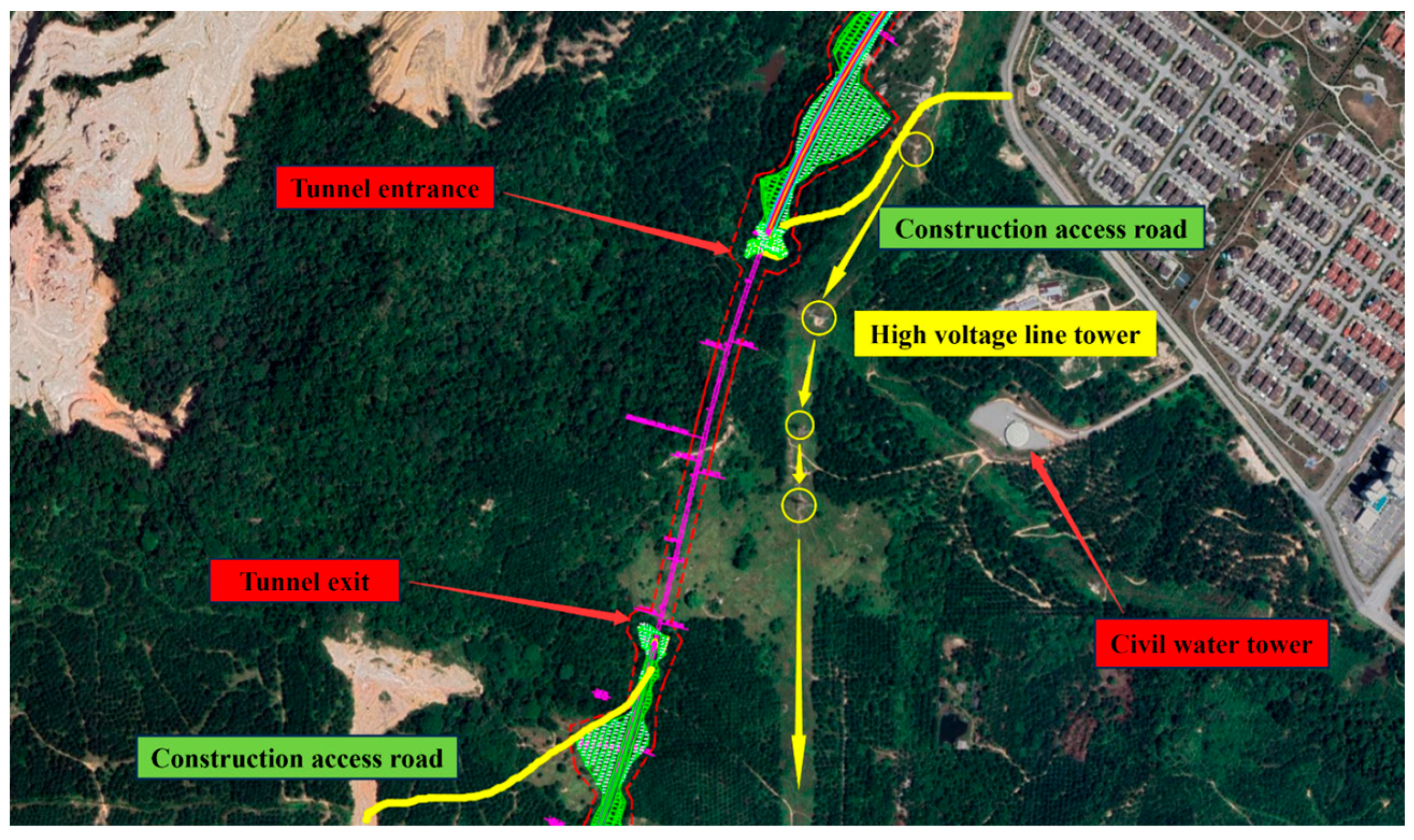
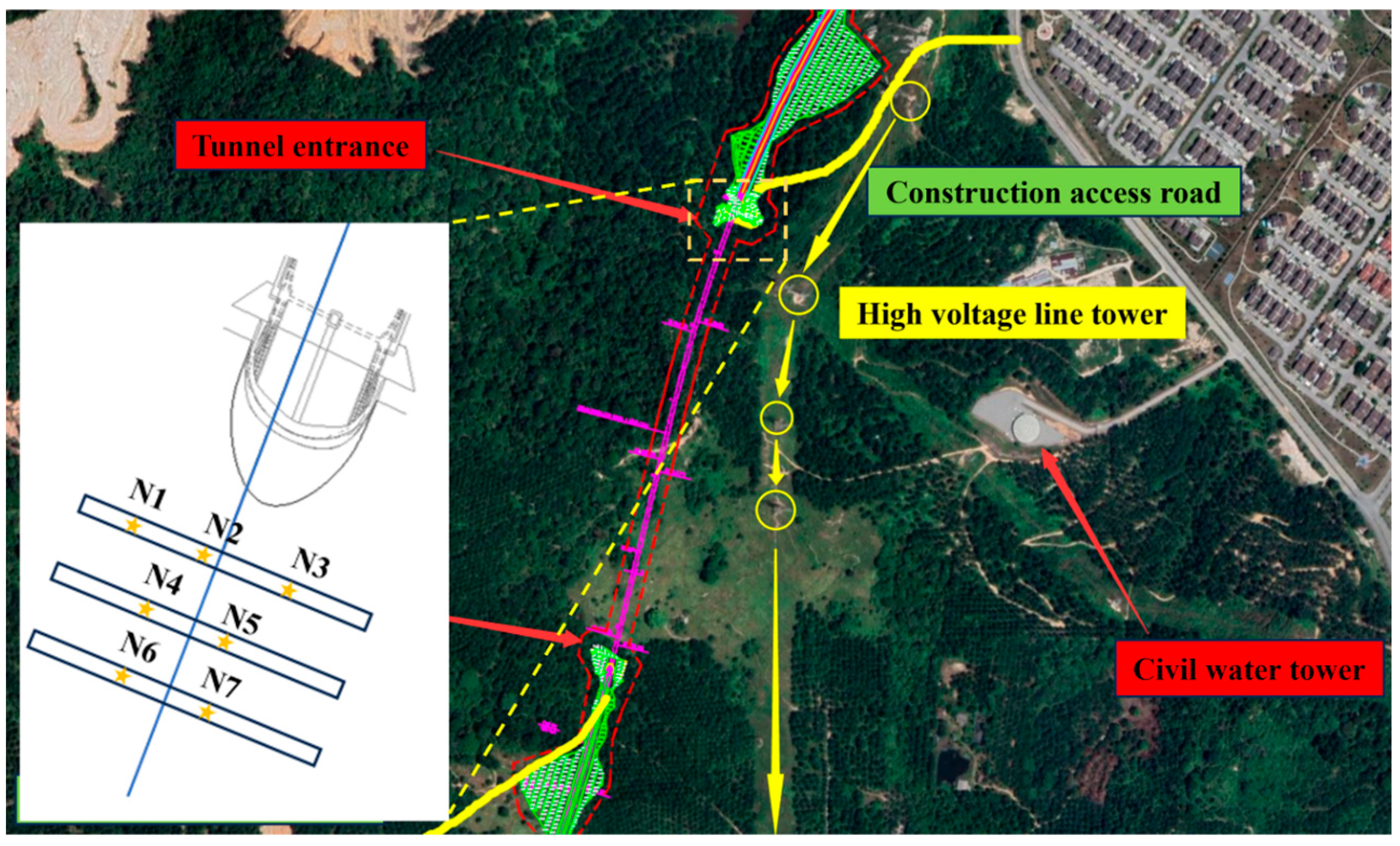
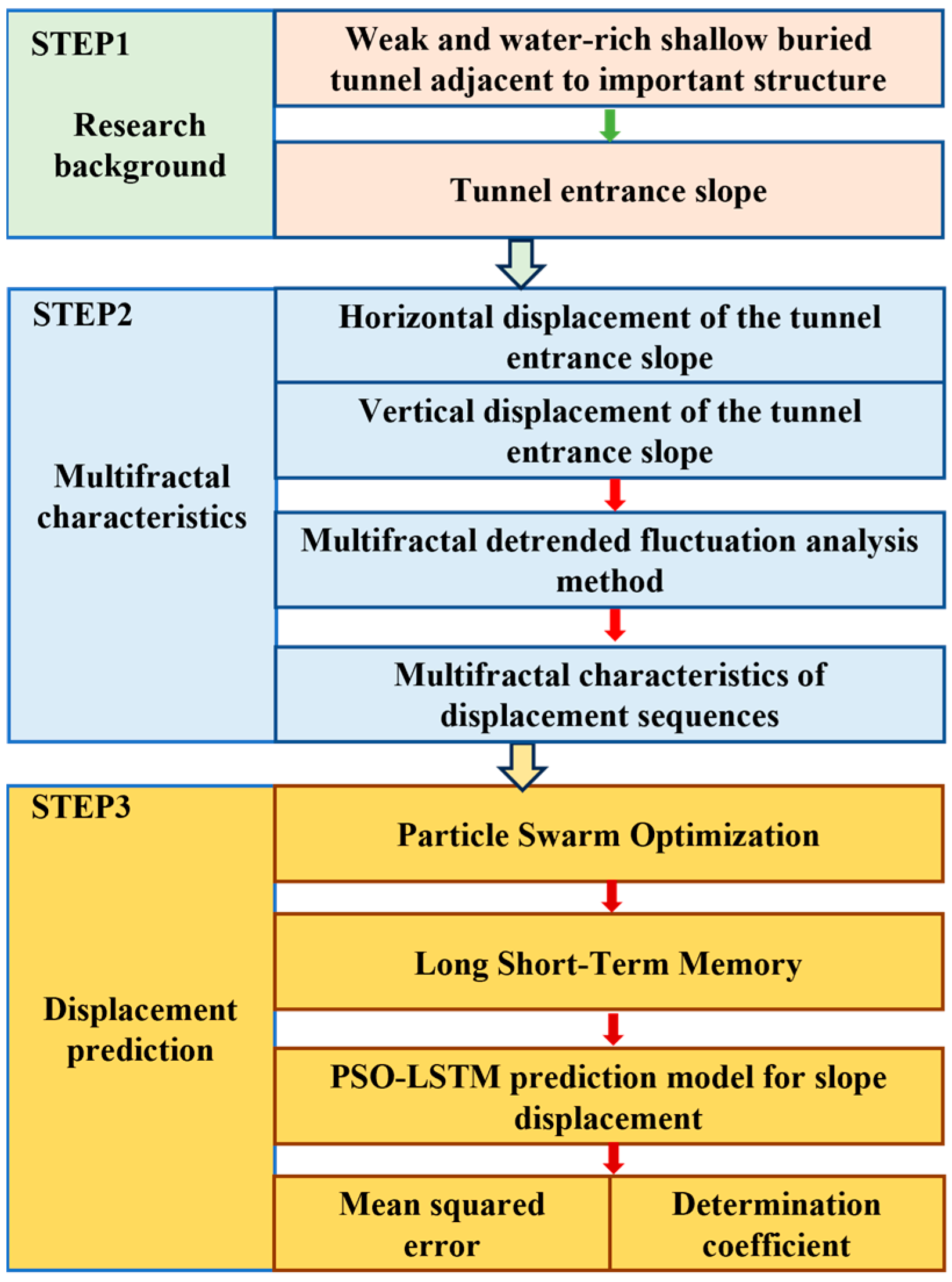

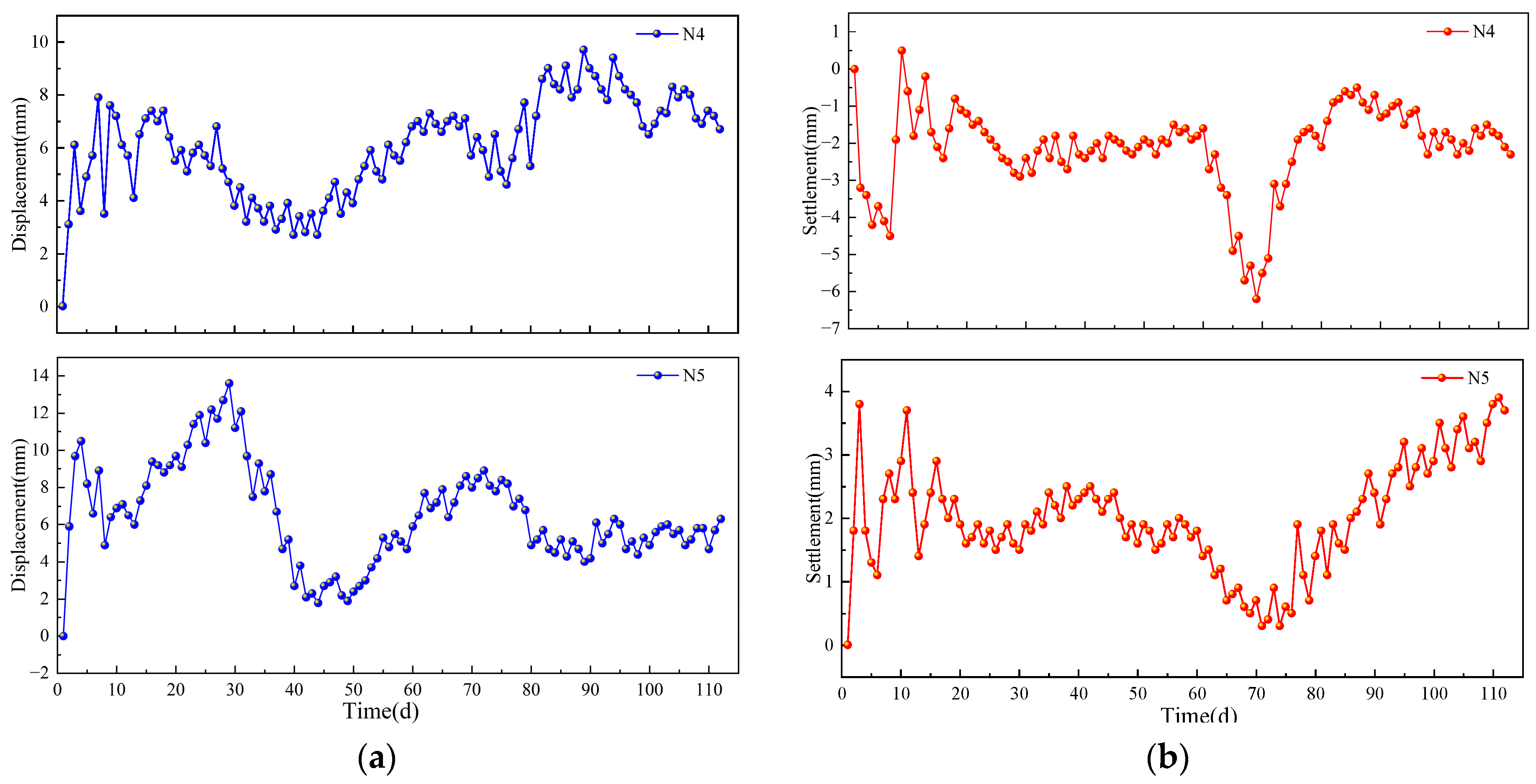
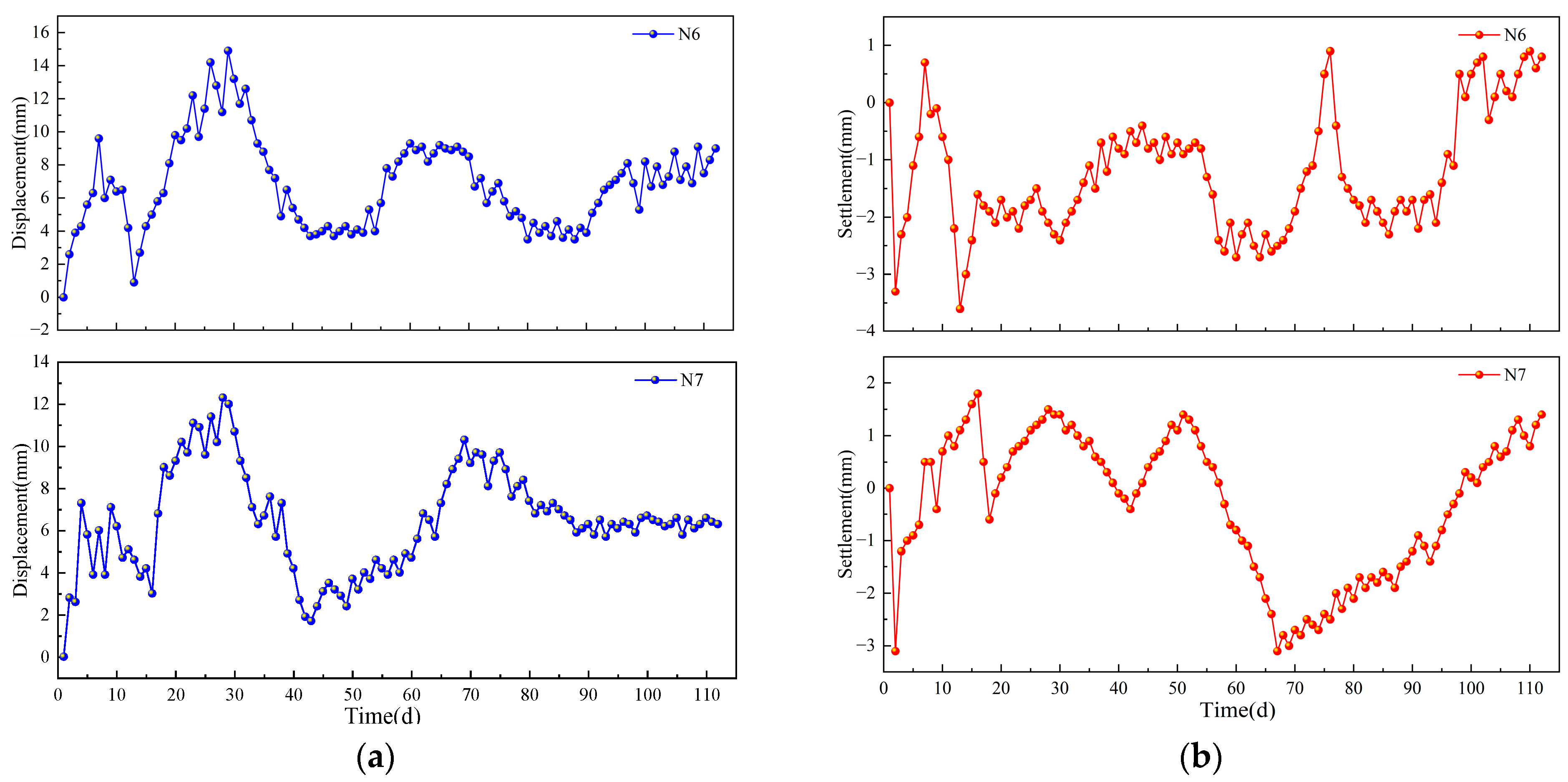

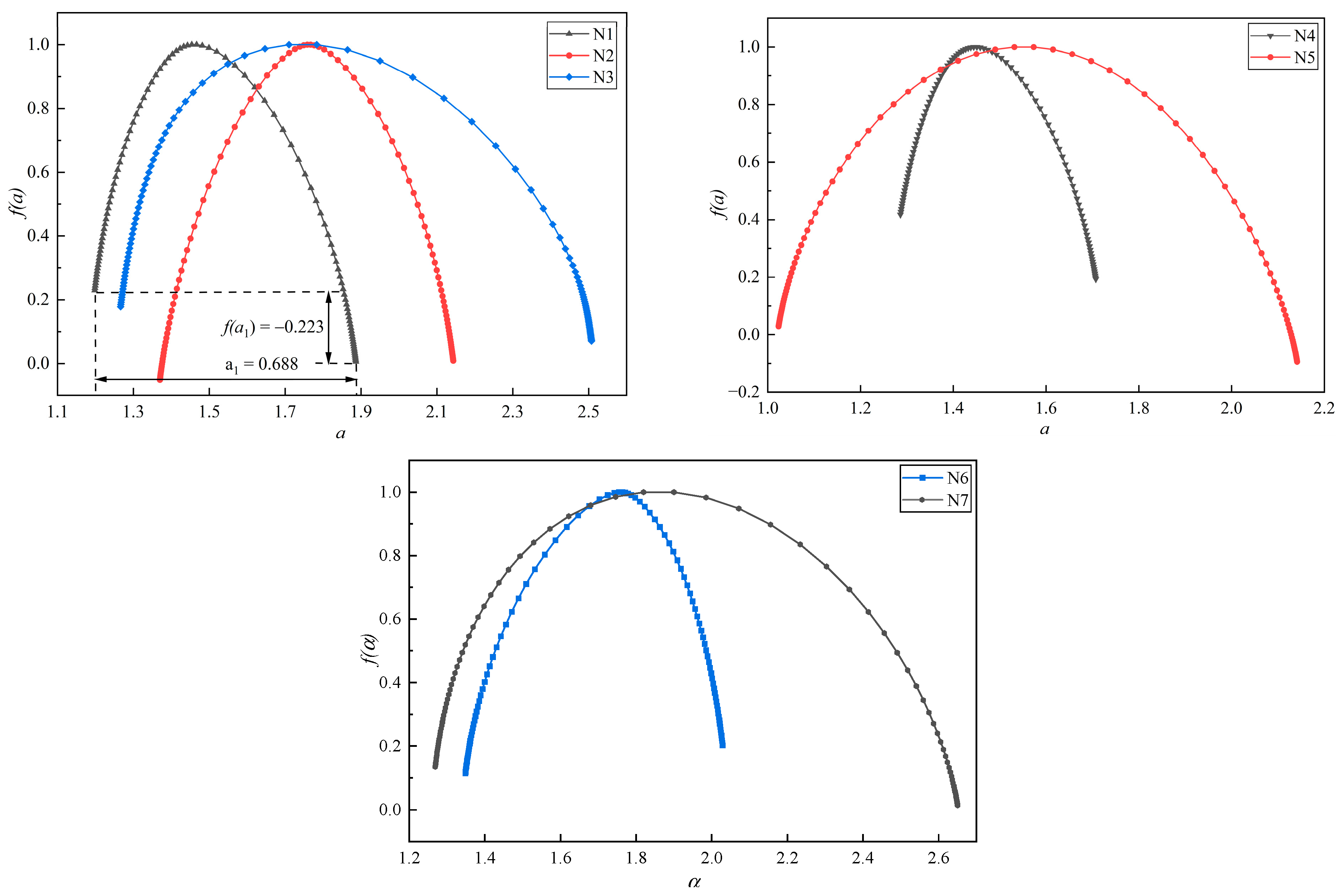
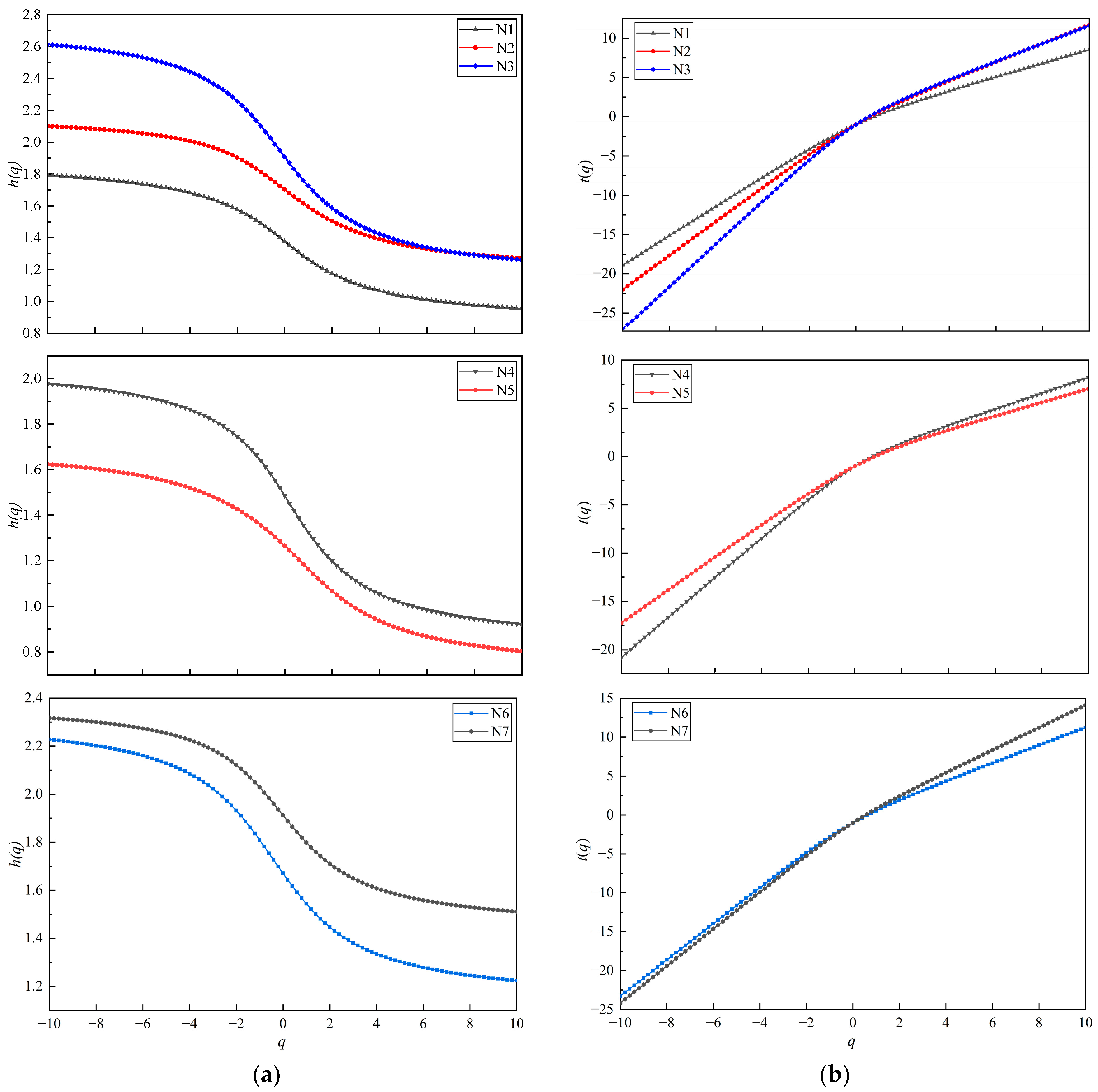

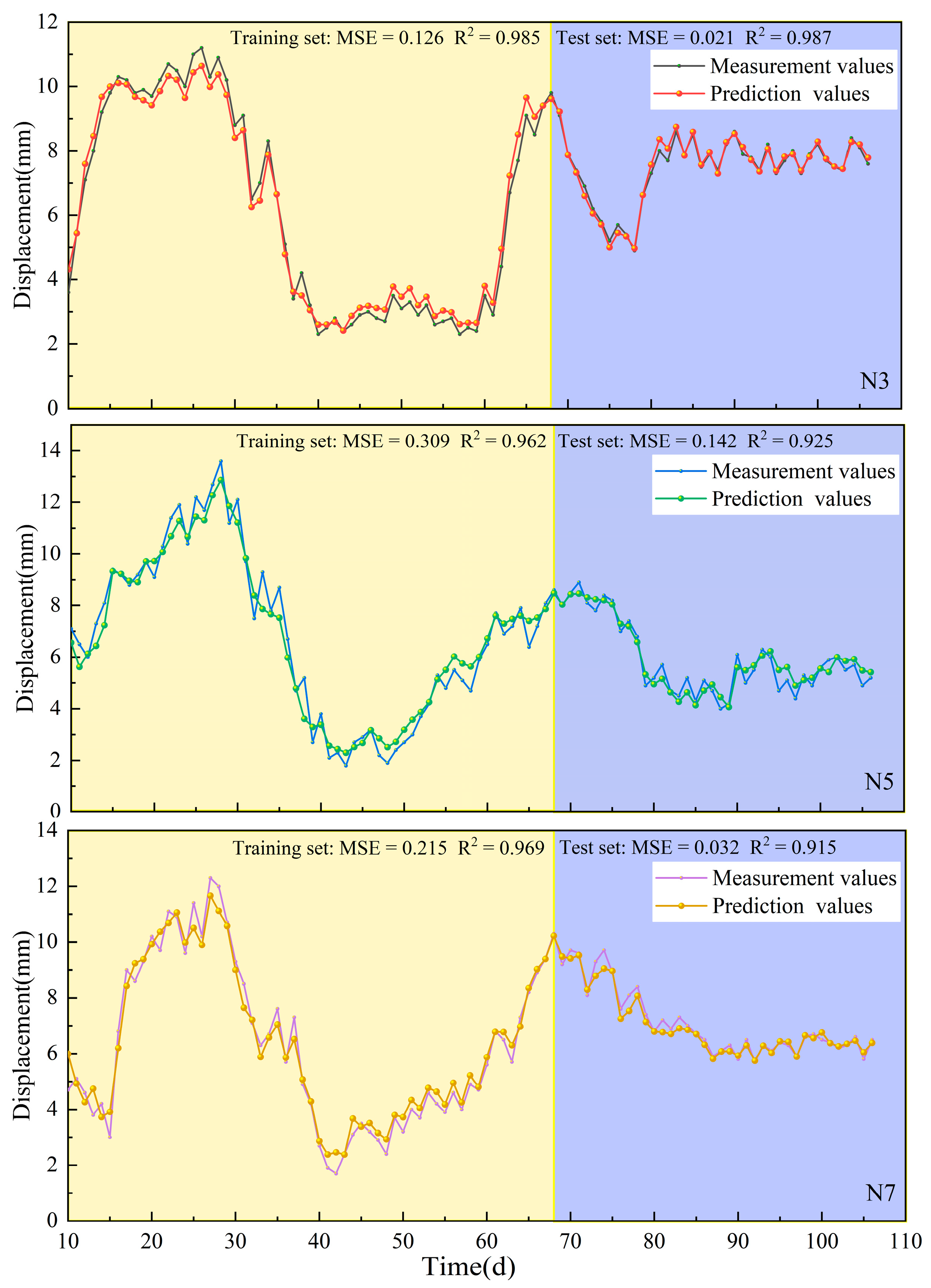

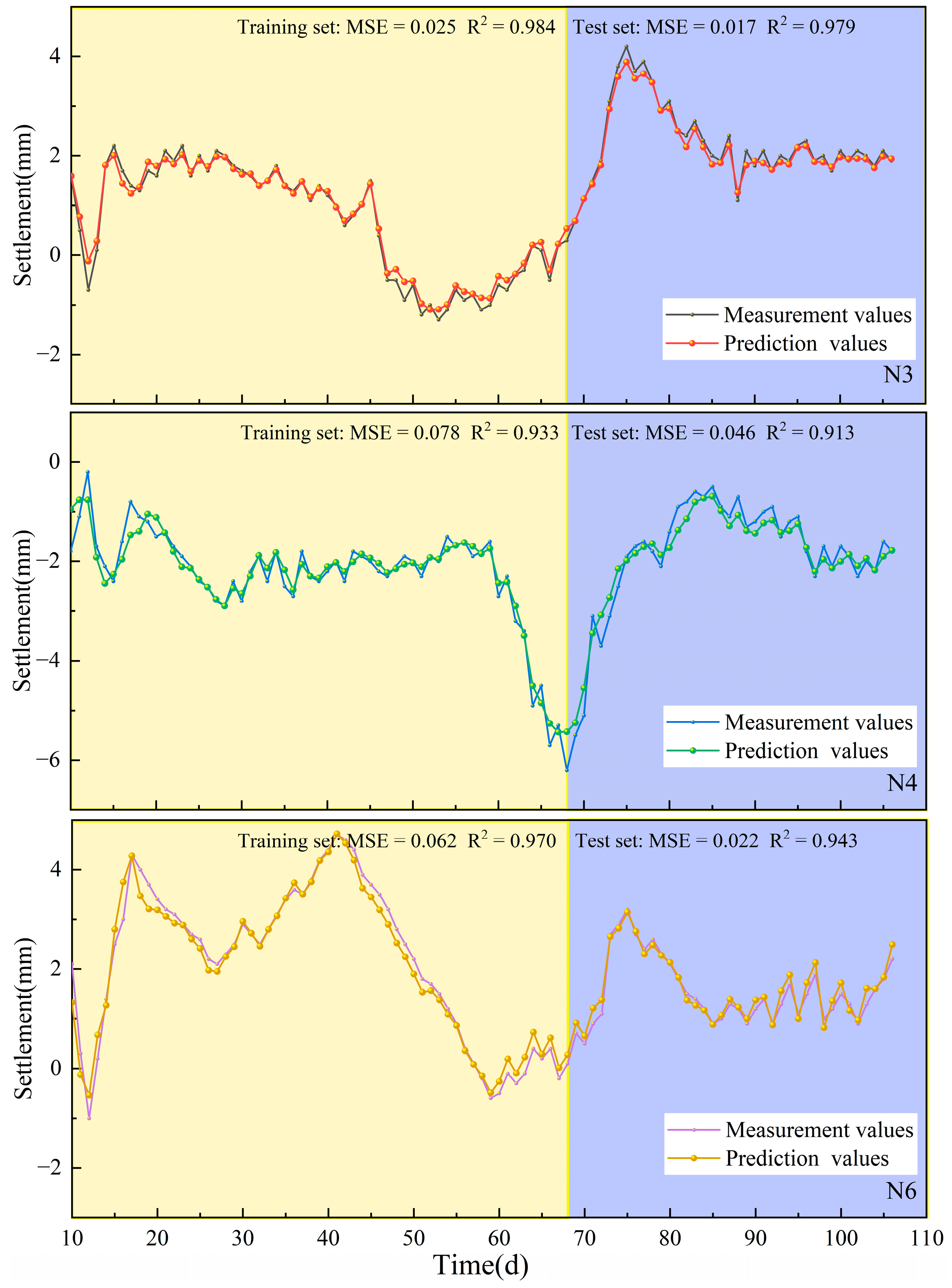
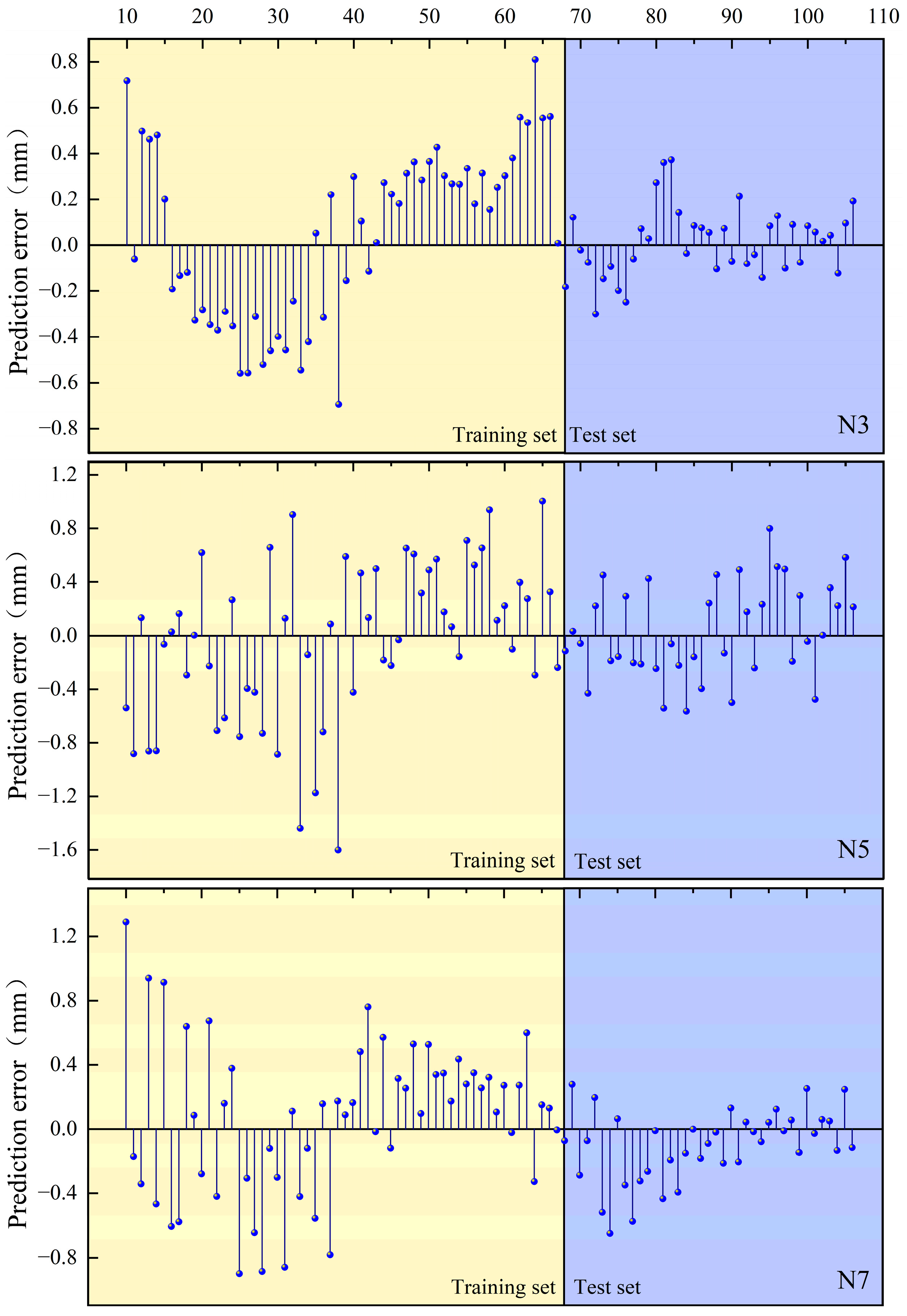
| Monitoring Points | Cross-Section 1 | Cross-Section 2 | Cross-Section 3 | |||||
|---|---|---|---|---|---|---|---|---|
| Eigenvalue | N1 | N2 | N3 | N4 | N5 | N6 | N7 | |
| 0.688 | 0.773 | 1.241 | 0.421 | 1.118 | 0.681 | 1.383 | ||
| −0.223 | 0.060 | −0.108 | −0.225 | −0.123 | 0.087 | −0.121 | ||
| Monitoring Points | Cross-Section 1 | Cross-Section 2 | Cross-Section 3 | |||||
|---|---|---|---|---|---|---|---|---|
| Eigenvalue | N1 | N2 | N3 | N4 | N5 | N6 | N7 | |
| 1.018 | 0.998 | 1.599 | 1.247 | 1.004 | 1.194 | 0.955 | ||
| 0.014 | 0.203 | −0.019 | 0.108 | 0.153 | −0.142 | 0.083 | ||
Disclaimer/Publisher’s Note: The statements, opinions and data contained in all publications are solely those of the individual author(s) and contributor(s) and not of MDPI and/or the editor(s). MDPI and/or the editor(s) disclaim responsibility for any injury to people or property resulting from any ideas, methods, instructions or products referred to in the content. |
© 2024 by the authors. Licensee MDPI, Basel, Switzerland. This article is an open access article distributed under the terms and conditions of the Creative Commons Attribution (CC BY) license (https://creativecommons.org/licenses/by/4.0/).
Share and Cite
Zhou, X.; He, Y.; Zhang, W.; Liu, D. Multifractal Characteristics and Displacement Prediction of Deformation on Tunnel Portal Slope of Shallow Buried Tunnel Adjacent to Important Structures. Buildings 2024, 14, 1662. https://doi.org/10.3390/buildings14061662
Zhou X, He Y, Zhang W, Liu D. Multifractal Characteristics and Displacement Prediction of Deformation on Tunnel Portal Slope of Shallow Buried Tunnel Adjacent to Important Structures. Buildings. 2024; 14(6):1662. https://doi.org/10.3390/buildings14061662
Chicago/Turabian StyleZhou, Xiannian, Yurui He, Wanmao Zhang, and Dunwen Liu. 2024. "Multifractal Characteristics and Displacement Prediction of Deformation on Tunnel Portal Slope of Shallow Buried Tunnel Adjacent to Important Structures" Buildings 14, no. 6: 1662. https://doi.org/10.3390/buildings14061662
APA StyleZhou, X., He, Y., Zhang, W., & Liu, D. (2024). Multifractal Characteristics and Displacement Prediction of Deformation on Tunnel Portal Slope of Shallow Buried Tunnel Adjacent to Important Structures. Buildings, 14(6), 1662. https://doi.org/10.3390/buildings14061662







